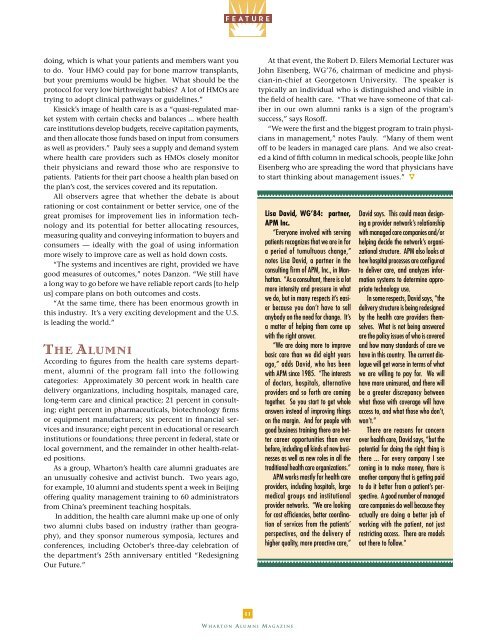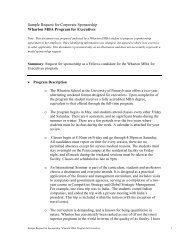wharton's prescription for health care - Wharton Magazine
wharton's prescription for health care - Wharton Magazine
wharton's prescription for health care - Wharton Magazine
Create successful ePaper yourself
Turn your PDF publications into a flip-book with our unique Google optimized e-Paper software.
FEATUREdoing, which is what your patients and members want youto do. Your HMO could pay <strong>for</strong> bone marrow transplants,but your premiums would be higher. What should be theprotocol <strong>for</strong> very low birthweight babies? A lot of HMOs aretrying to adopt clinical pathways or guidelines.”Kissick’s image of <strong>health</strong> <strong>care</strong> is as a “quasi-regulated marketsystem with certain checks and balances ... where <strong>health</strong><strong>care</strong> institutions develop budgets, receive capitation payments,and then allocate those funds based on input from consumersas well as providers.” Pauly sees a supply and demand systemwhere <strong>health</strong> <strong>care</strong> providers such as HMOs closely monitortheir physicians and reward those who are responsive topatients. Patients <strong>for</strong> their part choose a <strong>health</strong> plan based onthe plan’s cost, the services covered and its reputation.All observers agree that whether the debate is aboutrationing or cost containment or better service, one of thegreat promises <strong>for</strong> improvement lies in in<strong>for</strong>mation technologyand its potential <strong>for</strong> better allocating resources,measuring quality and conveying in<strong>for</strong>mation to buyers andconsumers — ideally with the goal of using in<strong>for</strong>mationmore wisely to improve <strong>care</strong> as well as hold down costs.“The systems and incentives are right, provided we havegood measures of outcomes,” notes Danzon. “We still havea long way to go be<strong>for</strong>e we have reliable report cards [to helpus] compare plans on both outcomes and costs.“At the same time, there has been enormous growth inthis industry. It’s a very exciting development and the U.S.is leading the world.”T HE ALUMNIAccording to figures from the <strong>health</strong> <strong>care</strong> systems department,alumni of the program fall into the followingcategories: Approximately 30 percent work in <strong>health</strong> <strong>care</strong>delivery organizations, including hospitals, managed <strong>care</strong>,long-term <strong>care</strong> and clinical practice; 21 percent in consulting;eight percent in pharmaceuticals, biotechnology firmsor equipment manufacturers; six percent in financial servicesand insurance; eight percent in educational or researchinstitutions or foundations; three percent in federal, state orlocal government, and the remainder in other <strong>health</strong>-relatedpositions.As a group, <strong>Wharton</strong>’s <strong>health</strong> <strong>care</strong> alumni graduates arean unusually cohesive and activist bunch. Two years ago,<strong>for</strong> example, 10 alumni and students spent a week in Beijingoffering quality management training to 60 administratorsfrom China’s preeminent teaching hospitals.In addition, the <strong>health</strong> <strong>care</strong> alumni make up one of onlytwo alumni clubs based on industry (rather than geography),and they sponsor numerous symposia, lectures andconferences, including October’s three-day celebration ofthe department’s 25th anniversary entitled “RedesigningOur Future.”At that event, the Robert D. Eilers Memorial Lecturer wasJohn Eisenberg, WG’76, chairman of medicine and physician-in-chiefat Georgetown University. The speaker istypically an individual who is distinguished and visible inthe field of <strong>health</strong> <strong>care</strong>. “That we have someone of that caliberin our own alumni ranks is a sign of the program’ssuccess,” says Rosoff.“We were the first and the biggest program to train physiciansin management,” notes Pauly. “Many of them wentoff to be leaders in managed <strong>care</strong> plans. And we also createda kind of fifth column in medical schools, people like JohnEisenberg who are spreading the word that physicians haveto start thinking about management issues.” ”Lisa David, WG’84: partner,APM Inc.“Everyone involved with servingpatients recognizes that we are in <strong>for</strong>a period of tumultuous change,”notes Lisa David, a partner in theconsulting firm of APM, Inc., in Manhattan.“As a consultant, there is a lotmore intensity and pressure in whatwe do, but in many respects it’s easierbecause you don’t have to sellanybody on the need <strong>for</strong> change. It’sa matter of helping them come upwith the right answer.“We are doing more to improvebasic <strong>care</strong> than we did eight yearsago,” adds David, who has beenwith APM since 1985. “The interestsof doctors, hospitals, alternativeproviders and so <strong>for</strong>th are comingtogether. So you start to get wholeanswers instead of improving thingson the margin. And <strong>for</strong> people withgood business training there are better<strong>care</strong>er opportunities than everbe<strong>for</strong>e, including all kinds of new businessesas well as new roles in all thetraditional <strong>health</strong> <strong>care</strong> organizations.”APM works mostly <strong>for</strong> <strong>health</strong> <strong>care</strong>providers, including hospitals, largemedical groups and institutionalprovider networks. “We are looking<strong>for</strong> cost efficiencies, better coordinationof services from the patients’perspectives, and the delivery ofhigher quality, more proactive <strong>care</strong>,”David says. This could mean designinga provider network’s relationshipwith managed <strong>care</strong> companies and/orhelping decide the network’s organizationalstructure. APM also looks athow hospital processes are configuredto deliver <strong>care</strong>, and analyzes in<strong>for</strong>mationsystems to determine appropriatetechnology use.In some respects, David says, “thedelivery structure is being redesignedby the <strong>health</strong> <strong>care</strong> providers themselves.What is not being answeredare the policy issues of who is coveredand how many standards of <strong>care</strong> wehave in this country. The current dialoguewill get worse in terms of whatwe are willing to pay <strong>for</strong>. We willhave more uninsured, and there willbe a greater discrepancy betweenwhat those with coverage will haveaccess to, and what those who don’t,won’t.”There are reasons <strong>for</strong> concernover <strong>health</strong> <strong>care</strong>, David says, “but thepotential <strong>for</strong> doing the right thing isthere ... For every company I seecoming in to make money, there isanother company that is getting paidto do it better from a patient’s perspective.A good number of managed<strong>care</strong> companies do well because theyactually are doing a better job ofworking with the patient, not justrestricting access. There are modelsout there to follow.”11W HARTON ALUMNI MAGAZINE
















